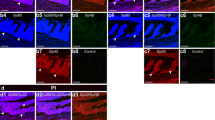Summary
Certain secretory cells in the hypophysial pars tuberalis of the Djungarian hamster display marked circannual structural alterations. The present investigation deals with the immunohistochemical properties of this cell group. A distinct TSH-like immunoreactivity was found in secretory cells of this type in the pars tuberalis of animals exposed to long photoperiods, whereas under short photoperiods the TSH-like immunoreactivity was nearly absent. In the pars distalis, the number and distribution of TSH-positive cells did not differ significantly between animals maintained under long and under short photoperiods. LH-and FSH-positive cells could not be detected in the pars tuberalis, but they are clearly present in the pars distalis of both groups of hamsters. Our immunocytochemical results suggest that photoperiodic stimuli influence the secretory activity of TSH-like immunoreactive cells in the pars tuberalis. A connection with the neuroendrocrine-thyroid axis is discussed.
Similar content being viewed by others
References
Aguado LI, Hancke JL, Rodriguez S, Rodríguez EM (1982) Changes in the luteinizing hormone content of the rat pars tuberalis during the estrus cycle and after lesions in the preoptic area. Neuroendocrinology 35:178–185
Dellmann H-D, Stoeckel ME, Hindelang-Gertner C, Porte A, Stutinsky F (1974) A comparative ultrastructural study of the pars tuberalis of various mammals, the chicken and the newt. Cell Tissue Res 148:313–329
Dierickx K, Lombaerts-Vandenberghe MP, Druyts A (1971) The structure and vascularization of the pars tuberalis of the hypophysis of Rana temporaria. Z Zellforsch 114:135–150
Girod C (1983) Immunocytochemistry of the vertebrate adenohypophysis. In: Handbuch der Histochemie. Vol. VIII, part 5. Fischer, Stuttgart, New York
Gross DS (1978) Effect of castration and steroid replacement on immunoreactive luteinizing hormone cells in the pars tuberalis of the rat. Endocrinology 103:583–588
Gross DS (1984) The mammalian hypophysial pars tuberalis: a comparative immunocytochemical study. Gen Comp Endocrinol 56:283–298
Hoffmann K (1981) Photoperiodism in vertebrates. In: Aschoff J (ed) Handbook of behavioral neurobiology. vol 5: Biological rhythms. Plenum Press, New York, London, pp 449–473
Hoffmann K (1985) Interaction between photoperiod, pineal and seasonal adaptation in mammals. In: Mess B, Rúzsás C, Tima L, Pévet P (eds) The pineal gland. Current state of pineal research. Elsevier, Amsterdam, pp 221–227
Knigge KM (1954) The effect of hypophysectomy on the adrenal gland of the hamster. Am J Anat 94:225–275
Rütten A (1986) Jahreszyklische morphologische Veränderungen an der Pars tuberalis der Adenohypophyse des Igels. Inaug Diss, Westfälische Wilhelms-Universität, Münster
Srebro Z, Lach H, Krawczyk S, Dzinbek K (1977) Annual cycle of activity in the nucleus tuberis hypothalami and the pars tuberalis of the hypophysis in the frog Rana esculenta. J Interdiscipl Cycle Res 8:55–64
Slernberger LA, Hardy PH Jr, Cuculis JJ, Meyer HG (1970) The unlabeled antibody-enzyme method of immunohistochemistry: preparation and properties of soluble antigen-antibody complex (horseradish peroxidase-antiperoxidase) and its use in identification of spirochetes. J Histochem Cytochem 18:315
Stoeckel ME, Porte A (1984) Fine structure and development of the pars tuberalis in mammals. In: Ultrastructure of endocrine cells and tissues. Motta PM (ed) Martinus Nijhoff Publ, Boston
Stoeckel ME, Porte A, Hindelang-Gertner C, Dellmann H-D (1973) A light and electron microscopic study of the pre-and postnatal development and secretory differentiation of the pars tuberalis of the rat hypophysis. Z Zellforsch 142:347–365
Turek FW, Campbell CS (1979) Photoperiodic regulation of neuroendocrine-gonadal activity. Biol Reprod 20:32–50
Vandenberghe MP, Dierickx K, Goossens N (1973) Seasonal changes of the ultrastructure of the pars tuberalis of the hypophysis of Rana temporaria. Z Zellforsch 145:459–469
Vaughan MK, Powanda MC, Richardson BA, King TS, Johnson LY, Reiter RJ (1982) Chronic exposure to short photoperiods inhibits free thyroxine index and plasma levels of TSH, T4, triiodothyronine (T3) and cholesterol in female Syrian hamsters. Comp Biochem Physiol 71A:615–618
Vriend J (1983) Evidence for pineal gland modulation of the neuroendocrine-thyroid axis. Neuroendocrinology 36:68–78
Vriend J, Reiter RJ, Anderson GR (1979) Effects of the pineal and melatonin on thyroid activity of male golden hamsters. Gen Comp Endocrinol 38:189–195
Vriend J, Sackman JW, Reiter RJ (1977) Effects of blinding, pinealectomy and superior cervical ganglionectomy on free thyroxine index of male golden hamsters. Acta Endocrinol 86:758–762
Vriend J, Wasserman RA (1986) Effects of afternoon injections of melatonin in hypothyroid male Syrian hamsters. Neuroendocrinology 42:498–503
Wittkowski W, Hewing M, Hoffmann K, Bergmann M, Fechner J (1984) Influence of photoperiod on the ultrastructure of the hypophysial pars tuberalis of the Djungarian hamster, Phodopus sungorus. Cell Tissue Res 238:213–216
Author information
Authors and Affiliations
Additional information
The study was supported by the Deutsche Forschungsgemeinschaft (Wi 558/3-1, Pe 134/2-4)
Rights and permissions
About this article
Cite this article
Wittkowski, W., Bergmann, M., Hoffmann, K. et al. Photoperiod-dependent changes in TSH-like immunoreactivity of cells in the hypophysial pars tuberalis of the Djungarian hamster, Phodopus sungorus . Cell Tissue Res. 251, 183–187 (1988). https://doi.org/10.1007/BF00215463
Accepted:
Issue Date:
DOI: https://doi.org/10.1007/BF00215463




